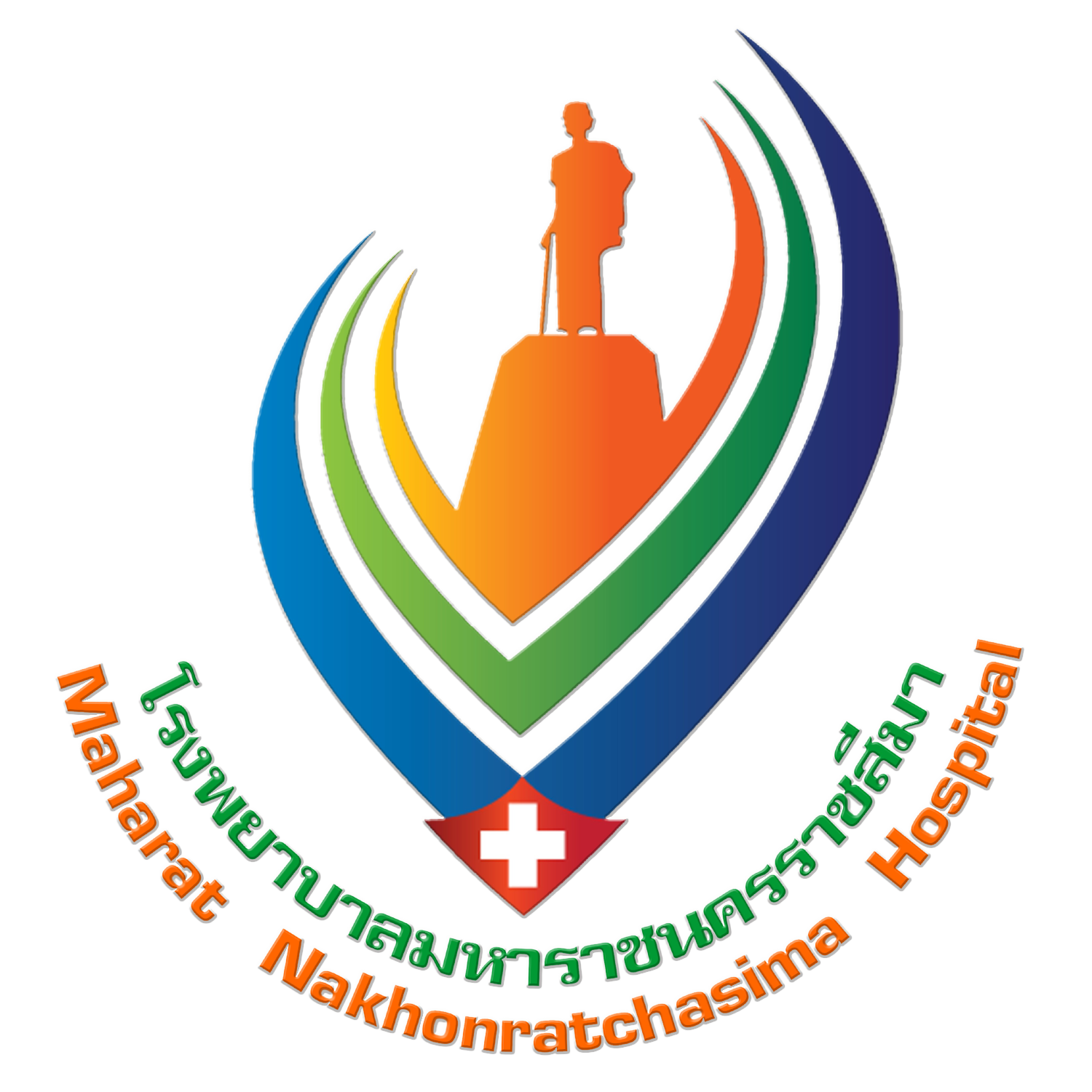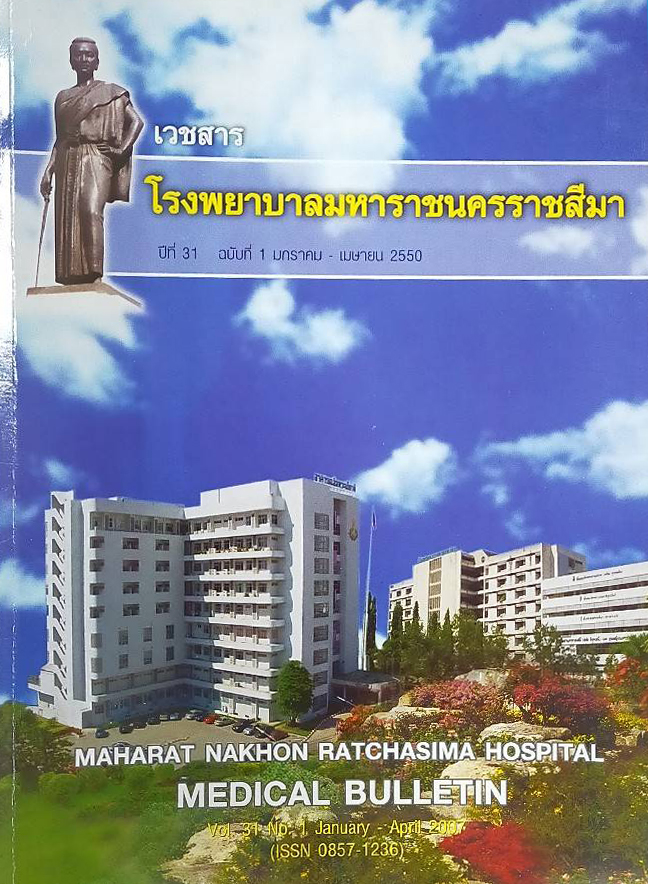การรอดชีวิตของผู้ป่วยเนื้องอกในสมองเด็กโรงพยาบาลมหาราชนครราชสีมา
Main Article Content
บทคัดย่อ
เนื้องอกในสมองพบบ่อยเป็นอันดับที่ 2 ของโรคมะเร็งในเด็ก การรักษาหลัก ได้แก่ การผ่าตัด และรังสีรักษา วัตถุประสงค์: เพื่อศึกษาอัตราการรอดชีพของผู้ป่วยเนื้องอกในสมองเด็ก ในโรงพยาบาลมหาราชนครราชสีมา ผู้ป่วยและวิธีการ: ทำการศึกษาย้อนหลังจากเวชระเบียนของผู้ป่วยที่เป็นเนื้องอกในสมอง ในเด็กอายุ 0-18 ปี ในโรงพยาบาลมหาราชนครราชสีมา ระหว่างปี พ.ศ. 2544-2548 ผลการรักษา: ผู้ป่วย 30 ราย อายุ 1.1-17.8 ปี เฉลี่ย 10.13 3.9 ปี อัตราส่วนชายต่อหญิงเท่ากับ 1 : 1 ชนิดของเนื้องอกสมองที่พบได้แก่ medulloblastoma ร้อยละ 30 brainstem tumor ร้อยละ 20 germ cell tumor ร้อยละ 16.7 a strocytoma ร้อยละ 13.3 ependymoma ร้อยละ 6.7 glioblastoma multiforme ร้อยละ 6.7 primitive neuroectodermal tumor ร้อยละ 3.3 และ pituitary tumor (unspecified type) ร้อยละ 3.3 อัตรา รอดชีพ 3 ปี ของผู้ป่วยเนื้องอกในสมองทั้งหมดร้อยละ 47.6 อัตราการรอดชีพ 3 ปี ของผู้ป่วย medulloblastoma, brainstem tumor และ astrocytoma เท่ากับร้อยละ 34.6, 16.7 และ 60 ตามลำดับ สรุป: ผู้ป่วยที่เป็นเนื้องอกในสมองเด็กในโรงพยาบาลมหาราชนคราชสีมา มีอัตราการรอดชีวิตใกล้เคียงกับการศึกษาอื่น ยกเว้นผู้ป่วย medulloblastoma ที่มีอัตราการรอดชีวิต 3 ปี ต่ำกว่าการศึกษาอื่น ๆ
Article Details

อนุญาตภายใต้เงื่อนไข Creative Commons Attribution-NonCommercial-NoDerivatives 4.0 International License.
เอกสารอ้างอิง
Strother DR, Pollack IF, Fisher PG, Hunter JV, Woo SY, Pomeroy SL, et al. Tumors of the central nervous system. In: Pizzo PA, Poplack DG, editors. Principles and practice of pediatric oncology. 4th ed. Philadelphia: Lippincott Williams & Wilkins; 2002 p. 751-842.
พงษ์จันทร์ หัตถีรัตน์. เนื้องอกที่สมองในเด็ก. ใน: พงย์จันทร์ หัตถีรัตน์, อำไพวรรณ จวนสัมฤทธิ์, ภัทรพร อิศรางกูร ณ อยุธยา, บรรณาธิการ.โลหิตวิทยาในเด็ก. พิมพ์ครั้งที่ 3. กรุงเทพฯ: ชัยเจริญ: 2538. หน้า 482-93.
Bleyer WA. Epidemiologic impact of children with brain tumors. Childs Nerv Syst 1999; 15: 758-63.
พงษ์จันทร์ หัตถีรัตน์. เนื่องอกที่สมองในเด็ก. ใน: ภัทรพร อิศรางกูร ณ อยุธยา, พงษ์จันทร์ หัตถีรัตน์, พิมล เชี่ยวศิลปี, บรรณาธิการ. โลหิตวิทยาในเล็ก. โครงการตำราศิริราชคณะแพทยศาสตร์ศิริราชพยาบาล, มหาวิทยาลัยมหิตล. กรุงเทพฯ: เรือนแก้วการพิมพ์; 2530. หน้า 482-93.
Hathirat P. Isarangkura P, Kunavisarut S,Kripaibul P, Pipatanakul S, Numnom S. Challenge of the two neural tumors: neuroblastoma and retinoblastoma. Southeast Asian J Trop Med Public Health 1985; 16:681-7.
พงษ์ศักดิ์ วิสุทธิพันธ์, สุรางค์ เจียมจรรยา. เนื้องอกในกะโหลกศีรษะ. ใน:พงย์ศักดิ์ วิสุทธิพันธ์,สุรางค์ เจียมจรรยา, บรรณาธิการ. โรคระบบประสาทในเด็ก. โครงการาศิริราช. คณะแพทยศาสตร์ศิริราชพยาบาล, มหาวิทยาลัยมหิดล. กรุงเทพฯ: กรุงเทพเวชสาร; 2525. หน้า 272-91.
Crist WM, Kun LE. Common solid tumors of childhood. N Engl J Med 1991; 324: 461-71.
Sangcham K, Shimahaharaja S. Ratanasiri B. Brain Tumors in Children. Thai Cancer 1988; 14: 74-85.
Tseng JH, Tseng MY. Survival analysis of children with primary malignant brain tumors in England and Wales: a population-based stady. Pediatr Neurosurg 2006; 42: 67-73.
Mauffrey C. Paediatric brainstem gliomas: prognostic factors and management. J Clin Neurosci 2006; 13: 431-7
Packer RJ, Prados M, Philips P, Nicholson HS, Boyett JM. Goldwein I, et al. Treatment of children with newly diagnosed brainstem gliomas with intravenous recombinant beta-interferon and hyperfractionated radiation therapy: a childrens cancer group phase I/ll study. Cancer 1996; 77: 2150-6.
Lankowsky P. Manual of pediatric hernatology and oncology. 4th edition. New York: Churchill Livingstone; 2005. p. 512-29.
Taylor RE, Bailey CC, Robinson KJ, Weston CL, Ellison D, Ironside J, et al. Results of a randomized study of preradiation chemotherapy versus radiotherapy alone for nonmetastatic medulloblastoma: The International Society of Paediatric Oncology/United Kingdom children's Cancer Study Group PNET-3 Study. J Clin Oncol 2003; 21: 1581-91.
Liu Y, Zhu Y, Gao L, Xu G, Yi J, Liu X, et al. Radiation treatment for medulloblastorma: a review of cases at a single institute. Jpn J Clin Oncol 2005; 35: 111-5.
Taylor RE, Bailey CC, Robinson KJ, Weston CL, Ellison D, Ironside J, et al. Impact of radiotherapy parameters on outcome in the International Society of Paediatric Oncology/United Kingdom Children's Cancer Study chemotherapy for MO-MI medulloblastoma. Int J Radiat Oncol Biol Phys 2004; 58: 1184-93.
Choinacka M, Skowronska-Gardas A. Medulloblastoma in childhood: impact of radiation technique upon the outcome of treatment. Pediatr Blood Cancer 2004; 42: 155-60.
Nasr A, Hasna AG.The prognostic impact of additional chemotherapy to radiation therapy for postoperative management of pediatric medulloblastoma. I Egypt Nati Canc Inst 2004; 16: 195-201.
Bailey CC,Gnekow A, Wellek S, Jones M, Round C, Brown J, et al. Prospective randomized trial of chemothcrapy given before radiotherapy in childhood medull oblastoma: International Society of Pardiatric Oncology (S1OP) and the (Geman) Soceity of Paediatric Oncology (GPO): SIOP II. Med Podiatr Oncol 1995; 25: 166-78.
Bauman G, Fisher B, Caimey E, Ranger A, Dar AR, Ross J, et al. Radiotherapy for pediatric central nervous system tumors: a regional cancer centre experience. J Neurooncol 2004; 68: 285-94.
Pollack IF, Claassen D, al Siboul Q, Janosky JE, Deutsch M. Low-grade gliomas of the cerebral hemispheres in children: an analysis of 71 cases. J Neurosurg 1995; 82: 536-47.
Leibel SA, Sheline GE, Wara WM, Boldrey EB, Nielsen SL. The role of radiation therapy in the treatrnent of astrocytomas. Cancer 1975; 35: 1551-7.
Bloom HJ, Glees J, Bell Ashley SE, Gorman C. The treatment and long-term prognosis of children with intracranial turnors: a study of 610 cases, 1950-1981. Int J Radiat Oncol Biol Phys 1990;18: 723-45.


